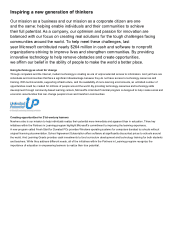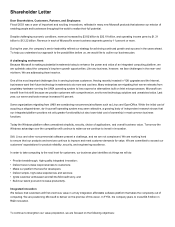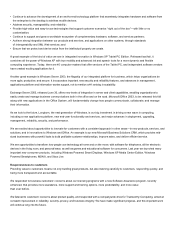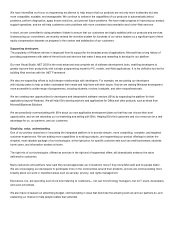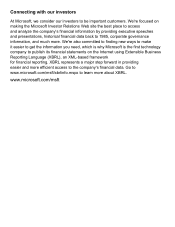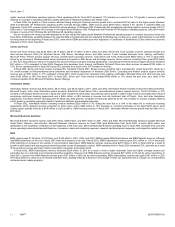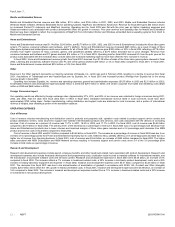Microsoft 2003 Annual Report Download - page 16
Download and view the complete annual report
Please find page 16 of the 2003 Microsoft annual report below. You can navigate through the pages in the report by either clicking on the pages listed below, or by using the keyword search tool below to find specific information within the annual report. MSFT 2003 FORM 10-K
3 /
Part I, Item 1
Home and Entertainment
Home and Entertainment segment includes the Microsoft Xbox video game system, PC games, the Home Products Division (HPD), and TV platform products.
Microsoft Xbox, released in fiscal 2002, is our next-generation video game console system that delivers high quality graphics and audio experiences. We offer
several types of entertainment products, including classic software games, online games, simulations, and sport and strategy games. HPD includes Microsoft’s line
of consumer hardware and software products, such as the Encarta line of learning products and services, the Picture It! consumer publishing and productivity line
of products and services, the Macintosh applications business, and the Microsoft hardware products.
Home and Entertainment segment oversees development and business strategy for the Microsoft Xbox video game system, including hardware, third-party
games development, games development published under the Microsoft label, Xbox and Xbox Live operations, marketing, research, and sales and support. The
segment leads the development efforts of our HPD product lines. The segment also carries out all retail sales and marketing for Microsoft Office, the Windows
operating systems, Xbox, games, and HPD products. The segment is responsible for the development, sales, and deployment of Microsoft’s TV platform products
for the interactive television industry.
INTERNATIONAL OPERATIONS
Microsoft develops and sells products throughout the world. Our three major geographic sales and marketing organizations are the Americas Region, the Europe,
Middle East, and Africa Region, and the Japan and Asia-Pacific Region. Pressure to globalize our pricing structure might require that we reduce the sales price of
our software in the United States and other countries. A number of other factors could also have a negative effect on our business and results from operations
outside of the United States, including changes in trade protection laws, policies and measures, and other regulatory requirements affecting trade and investment;
unexpected changes in regulatory requirements for software; social, political, labor, or economic conditions in a specific country or region, including foreign
exchange rates; difficulties in staffing and managing foreign operations; and potential adverse foreign tax consequences. A portion of international revenue is
hedged, thus offsetting a portion of the currency translation exposure.
EQUITY METHOD INVESTMENTS
We have entered into joint venture arrangements to take advantage of creative talent and content from other organizations. For example, we own 50 percent of
MSNBC Cable L.L.C., a 24-hour cable news and information channel, and 50 percent of MSNBC Interactive News L.L.C., an interactive online news service.
National Broadcasting Company (NBC) owns the remaining 50 percent of each of these joint ventures.
PRODUCT DEVELOPMENT
During fiscal years 2001, 2002, and 2003, research and development expense was $4.38 billion, $4.31 billion, and $4.66 billion, respectively. Those amounts
represented 17.3%, 15.2%, and 14.5%, respectively, of revenue in each of those years. During fiscal year 2001, $272 million of goodwill amortization was included
in research and development expense. No goodwill amortization is included in fiscal years 2002 and 2003, in accordance with Statement of Financial Accounting
Standards (SFAS) 142, Goodwill and Other Intangible Assets. We plan to continue spending significant amounts for research and product development.
Most of our software products are developed internally. We also purchase technology, license intellectual property rights, and oversee third-party development
and localization of certain products. We do not believe we are materially dependent upon licenses and other agreements with third parties relating to the
development of our products. Internal development allows us to maintain closer technical control over our products and gives us the freedom to designate which
modifications and enhancements are most important and when they should be implemented. We work to devise innovative solutions in computer science, such as
making computers easier to use, designing software for the next generation of hardware, improving the software design process, and investigating the
mathematical underpinnings of computer science. We have created a substantial body of development tools and have evolved development methodologies for
creating and enhancing our products. These tools and methodologies are also designed to simplify a product’s portability among different operating systems,
microprocessors, and computing devices. Product documentation is generally created internally. We strive to obtain information at the earliest possible time about
changing usage patterns and hardware advances that may affect software design. Before releasing new software platforms, we provide to application vendors a
range of resources and guidelines for development, training, and testing.
Microsoft .NET is our strategy and implementation of connecting people, information, systems and devices through the use of Web services. It includes
everything needed to develop and deploy a Web service-connected IT architecture: servers to host Web services (Windows Server System and Windows Server
2003), development tools to create them (Microsoft Visual Studio .NET 2003 and the .NET Framework), applications and smart devices that use them (Microsoft
Office System, smart phones, Pocket PCs and PCs), and a worldwide network of more than 35,000 Microsoft Certified Partner organizations – people whose skills
and experience can help businesses get the most from their IT investments. Built on industry standards, Web services enable applications to communicate and
share data over the Internet or an intranet, regardless of operating system or programming language.
We believe that establishing trust in computing will be critical to our future success. Trustworthy Computing means helping ensure a safe and reliable
computing experience that is both expected and taken for granted. Achieving Trustworthy Computing will require the collaboration of hardware and software
companies, academic and government research institutions, and policy leaders. For us, Trustworthy Computing is a company-wide initiative aimed at changing
how we do business that will take fundamental research and advances in engineering, as well as changes to business culture and business processes to
accomplish. We think there are four factors that affect the level of trust that people place in computing: Security, Privacy, Reliability, and Business Integrity.
Security means the customer can expect that systems are resilient to attack, and that the confidentiality, integrity, and availability of the system and its data are
protected. Privacy means the customer is able to control personal information and feel confident it is not only safe and used appropriately, but in a way that
provides value. A reliable system or


